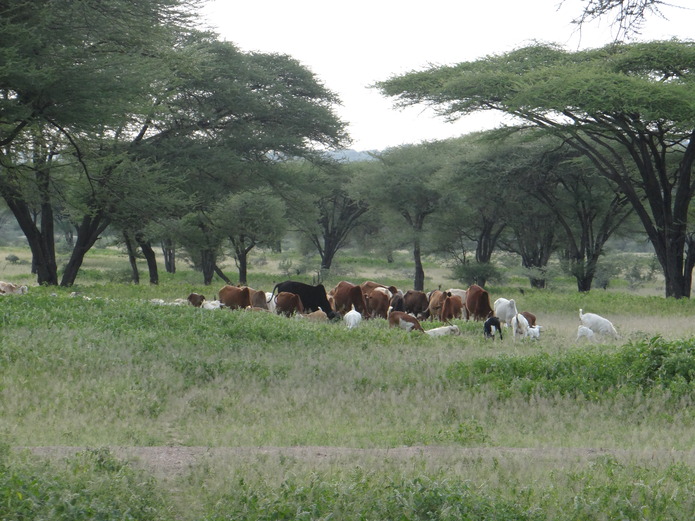
Government of the United Republic of Tanzania
Natural Forest Resources Management and Agroforestry Centre (NAFRAC)
In the mid-1980s, the Shinyanga region had become greatly degraded because of forest clearing to combat tsetse fly, create land and space for agriculture and cash cropping, and accommodate the needs of a growing population. This led to soil erosion, water scarcity and the loss of indigenous tree species, pasture and livelihoods. Early attempts to launch reforestation activities by Tanzania’s government and development agencies like the World Bank had been unsuccessful. The Shinyanga Soil Conservation Programme - better known in Swahili as Hifadhi Ardhi Shinyanga (HASHI) - was started in 1986, with the help of funding from the government of Tanzania and long-term support from the Norwegian Agency for Development Cooperation (NORAD) and the World Agroforestry Centre (ICRAF). By 2004, about 350,000 hectares of ecologically managed pastures and woodlots had been restored or created in 833 villages encompassing a population of about 2.8 million.
HASHI resurrected the ngitili or “fodder reserves” traditional approaches of conserving grazing areas in the dry season, and controlling harvesting to enhance livelihoods. Many ngitili had been destroyed during Tanzania’s “villagisation” programme or “Ujamaa” of the 1960s, which had aimed to transform rural society to social communities, but resulted in the traditional institutions, knowledge and practices being disregarded. Early attempts to plant (mainly exotic) trees supplied by the government largely failed as they lacked local ownership and acceptance, but this changed when the HASHI programme was launched. Policies that encouraged forest degradation were replaced, and the traditional system of ngitili was reintroduced. The Sukuma agro-pastoralists were given responsibility for conserving forest plots, and multiple tree nurseries were set up at the village and district levels by local entrepreneurs.
Local households benefit from reduced erosion, and improved availability of water and forestry products (fuel, building timber, fruits, gum, medicines, and fodder) which has increased incomes from agro-pastoralism, improved dietary diversity and provided greater livelihood security. Restored woodlands also provide fodder for oxen at critical times in the dry season and many herb varieties have been harvested for sale and local use. The establishment of over 1,500 tree nurseries across the region has led to the creation of local jobs. Revenues from the sale of products such as seedlings, honey and poles has increased, and farm yields have improved with the help of agroforestry practices such as planting of nitrogen-fixing species. Teachers in the region have also been trained about environmental issues.
In an area of about 350,000 hectares, over 152 species of trees, shrubs and climbers have been planted, and up to 30 different varieties of grass and herbs. With the restoration zone, over 145 bird and 13 mammal species have been recorded. The vegetation is estimated to have sequestered 23.21 million tonnes of carbon over 25 years, and the restored woodlands also help to improve water catchment conditions and reduce soil erosion. Indigenous plants and trees species are also more prevalent, and are used as medicine to treat different diseases.
Changes to unsustainable land management policies constituted one of the key factors that spurred the forest restoration in Shinyanga. Policies that encouraged forest degradation were replaced with those that respected and integrated local communities and their knowledge, practices and institutions; with changes in tenure that allowed them access to, and control over natural resources. This increased the willingness of individuals and groups to restore and manage forests sustainably. Funding from the government of Tanzania, Norwegian Agency for Development Cooperation (NORAD) and the World Agroforestry Centre (ICRAF) supported the transition, in addition to community leadership and local recognition of the importance of restoration.
The HASHI programme was acknowledged at the Johannesburg World Summit on Sustainable Development (2002), and was selected as one of the winners of the Equator Initiative Award.
With the HASHI programme coming to an end in 2004, it was officially succeed by the Natural Resources Management and Agroforestry Centre (NAFRAC). The ngitili system remained, and has been replicated in other regions in the country. NAFRAC is managed by the Forest Service Agency (TFS) and the Tanzania Forestry Research Institute (TAFORI).
Rapid population growth (~2.9% per year) leads to increased land exploitation that threatens many ngitili areas. The number of livestock has also increased at a similar rate. This is compounded by an upward trend in human-wildlife conflict, especially in the form of crop damage.